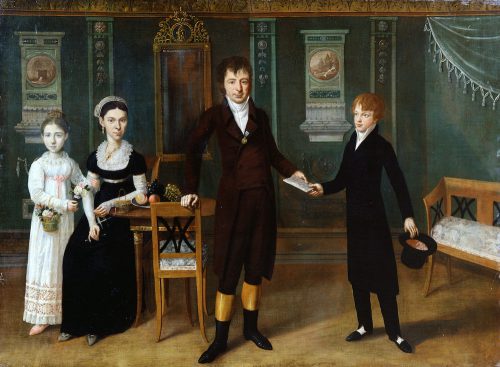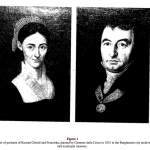9859 FAMILY OF KONRAD GÖSCHL IN A NEOCLASSICAL INTERIOR BY CLEMENS JOHANN EVANGELIST DELLA CROCE (1782-1824) Indistinctly Signed And Dated 1816. Measurements: Height: 21 1/2″ (55 cm) Width: 41″ (104 cm)

Research
Oil on canvas, laid to board.
Marks:
Signed and dated Clemens de la Croce pinxit 1816
Document inscribed BURGHAUSEN
Provenance:
Mallett, Bourdon House, 1984
Private Collection, Stockholm.
This painting of a group within a neoclassical interior almost certainly depicts the apothecary Konrad Göschl and his wife Franziska, possibly with their children. It was painted by the artist Clemens Johann Evangelist della Croce (1782-1824), active in Burghausen, Bavaria.
Clemens was the 16th son of Austrian artist Johann Nepomuk della Croce. Born in Tyrol in 1736, Johann worked in Italy, Germany, England and France before settling in Burghausen. Johann’s prolific oeuvre included roughly 5,000 portraits including the well-known painting of Wolfgang Amadeus Mozart with his sister and father. Clemens took over his father’s workshop upon Johann’s death in 1819. He also worked as an art teacher in Burghausen and his paintings, executed in the baroque-classical style of his father, include frescoes, portraits and altarpieces. The present work is a departure from this genre, leaning more toward a neoclassical style.
In the present painting, Konrad Göschl is the central figure, depicted handing a document inscribed “Burghausen” to a young man. Konrad was an apothecary in Burghausen, and a senior lieutenant of the Prussian Landwehr who received the royal Prussian order of merit, the highest form of decoration, for his service against the armies of Napoleon in 1814. He also received an additional “Bavarian” award in 1815 for civil service, and wears this medal on his lapel in the present painting. His wife Franziska is seated at the table, knitting. The young girl standing to her left was apparently not painted at the same time as the other figures, or was altered, as evidenced by her unusual pallor and the fact that her dress covers the original signature on the lower left of the canvas.
The director of the Burghausen city archive and municipal museum brought to our attention a pair of recently-acquired portraits of Konrad Göschl and Franziska, also painted by Clemens della Croce in 1815 (figure 1), which strongly supports the identification of the sitters in the present painting. In his portrait Konrad is again depicted wearing his civilian service medal.
The painting can also be viewed as a significant art historical document as it shows an interesting neoclassical interior of the 1770s, but furnished with cherry and ebonized wood seating furniture, representing the first flowerings of the Biedermeier style, which would have been on the cutting edge of taste in 1816.


Comments are closed.